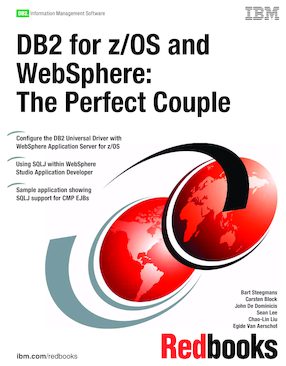Chapter 1. Introduction to DB2 for z/OS and OS/390
1.1 Relational database management systems
1.2 The DB2 Universal Database Family
1.3 Components of DB2 UDB for z/OS and OS/390
1.4 DB2 data structures
1.5 Structured query language (SQL)
1.6 DB2 concepts
1.7 Accessing DB2 from a Java environment
1.8 IBM DB2 Universal Driver for SQLJ and JDBC
1.9 Using the DB2 Universal Driver for SQLJ and JDBC
Chapter 2. Introduction to WebSphere for z/OS
2.1 Java 2 Enterprise Edition (J2EE) overview
2.2 WebSphere Application Server architecture
2.3 WebSphere Application Server administration
2.4 The WebSphere family
2.5 WAS 5.0.2 features and J2EE support
Chapter 3. WebSphere - DB2 environment
3.1 Introduction to the sample scenario setup
3.2 Introduction to DB2 drivers for Java
3.3 Data Source definitions in WAS v5
3.4 The IBM DB2 Universal Driver for SQLJ and JDBC
3.5 Configuring Universal JDBC Driver type 2 connectivity
3.6 Configuring Universal JDBC Driver type 4 connectivity
3.7 Summary
Chapter 4. DB2 and Java architecture guide
4.1 Introduction to J2EE data access architecture
4.2 Servlets and JavaServer Pages
4.3 Enterprise JavaBeans
4.4 Session Beans
4.5 Stateless session Beans
4.6 Stateful session Beans
4.7 Entity Beans
4.8 Bean-Managed Persistence entity Beans
4.9 Container-Managed Persistence entity Beans
4.10 Message-driven Beans
4.11 Session facade pattern
4.12 Stored procedures
4.13 Web services
4.14 SQLJ support
4.15 Java Data Objects
4.16 EJB Beans summary
Chapter 5. DB2 application development in a WebSphere environment
5.1 JDBC and SQLJ application programming comparison
5.2 JDBC application programming concepts
5.3 SQLJ application programming concepts
5.4 Preparing JDBC and SQLJ applications for execution
5.5 Impact of different DB2 bind options on Java applications
5.6 Special registers
Chapter 6. WebSphere - DB2 security
6.1 Introduction to authentication, authorization, and auditing
6.2 DB2 auditing
Chapter 7. SQLJ
7.1 Writing SQLJ versus JDBC applications
7.2 Profile customization
7.3 Application design
7.4 SQLJ in WebSphere Studio Application Developer
7.5 Deployment to WebSphere Application Server
7.6 Summary
Chapter 8. Transaction management in a WebSphere environment
8.1 What transactions are
8.2 WebSphere transaction management
8.3 WebSphere resources and transaction support
8.4 DB2 as a transaction manager
8.5 DB2 as a resource manager
8.6 Considerations for two-phase commit processing
Chapter 9. DB2 locking in a WebSphere environment
9.1 DB2 locking
9.2 Transaction isolation
9.3 WebSphere transaction-related deployment descriptors
9.4 Container-managed persistence generated SQL
Chapter 10. DB2 - WebSphere performance aspect
10.1 Recommended hardware and software configuration
10.2 WebSphere Application Server connection pooling
10.3 DB2 and JDBC
10.4 WLM classification of WAS and its impact on DB2
10.5 Tuning the storage for z/OS and the Java Virtual Machine
Chapter 11. Sample application
11.1 Introduction
11.2 MVC model with entity Beans and a session Bean
11.3 The View component of the MVC model
11.4 Controller component of MVC
11.5 The enterprise J2EE application
11.6 Deployment of the EAR file
11.7 Test of the application
